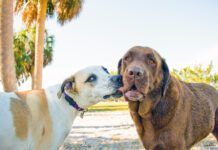[Updated June 26, 2017]
July 4th is a dreaded time for thousands of noise-sensitive dogs and their owners. In many parts of the country sound-sensitive dogs and the humans who love them are already struggling with the effects of thunderstorms – thank goodness fireworks really only occur once a year. Our Corgi, Lucy, is a thunder-phobe, and we know all too well the impact thunder and firecrackers have on her (and our) quality of life. Fortunately, the following can make life better for you and your dog during noisy events.
1. Stay Home
Ever since the mid-1980s, when we shared our lives with our first sound-sensitive dog, Independence Day and New Year’s Eve have been occasions to stay home rather than go out and celebrate. You can relieve some of your dog’s stress with just your comforting presence. It’s harder to stay home consistently during thunderstorms unless you have the good fortune to work from home, but there may be times when you can make the choice to pass on an optional outing if a storm is coming.
2. Hold Your Dog
Despite what you’ve heard to the contrary, it’s perfectly okay to comfort your sound-stressed dog, as long as you do it calmly. If she wants to be in your lap, or next to you on the couch or the floor, let her. If it helps her to calmly put your arms around her and hold her, or do calming massage or T-Touch, do it. This is not operant reinforcement of her fear; it just helps her feel better – and may even work to classically counter-condition her very negative association with thunder or fireworks.
It doesn’t help, though, if you are stressed, chanting, “It’s okay, it’s okay,” over and over, while rubbing your dog as if you were drying her off with a towel. In other words, you need to stay calm, too!
3. Manage/Minimize Intensity of the Stimulus
Reduce the intensity of the fear-causing stimuli by closing curtains to shut out the visual effects (flashes of lighting, lights, or sparks of fireworks) that your dog associates as reliable predictors of the bad noise.
White noise machines can help mask the sounds; so can the especially composed “Through a Dog’s Ear” CDs, especially if you have played the CDs during relaxing times so your dog already has a calm, positive association with the music. (If you play them only during storms he may form a negative association with the otherwise calming music.)
You can also use Mutt Muffs to muffle the sound. Use positive classical conditioning to convince him that the earmuffs make wonderful treats happen. (Of course, if he is disturbed by the Muffs even after multiple classical conditioning sessions, don’t force them on him.)
4. Counter-Condition
Use recordings of thunderstorm sounds and/or storm sounds. Start with the volume at barely audible levels – or even inaudible levels, if your dog is still worried. Pair this low-level sound with wonderful things, such as high-value treats, or games of fetch or tug, until your dog gets happily and consistently excited in anticipation of his favorite things when you turn the sound on. Then turn the volume up slightly and continue.
This is a long-term project; don’t expect to turn up the volume every session. This won’t fix everything; your storm-phobic dog may also react to wind, rain, and even the change in barometric pressure, but it’s a start. When a real storm approaches (or fireworks begin) try the counter-conditioning strategy at the earliest hint of stimulus, and keep your dog playing the game as long as possible. When he’s too stressed to take treats or play, revert to other strategies. It helps if you’re lucky with a lot of near-miss storms that give you conditioning opportunities without reaching full intensity.
5. Drugs
Short-acting anti-anxiety medications can greatly enhance your sound-sensitive dog’s quality of life. I give Lucy Alprazolam (Xanax) when storms threaten. It not only helps ease her immediate fears but also seems to have reduced her strong reactions to storms in general.
I can’t tell you which drug is right for your dog, but veterinary behaviorist Dr. Karen Overall strongly cautions against using tranquilizers such as acepromazine for sound-anxiety behaviors. “Ace” is a dissociative anesthetic; it scrambles perceptions, which may make the dog more fearful. If your vet isn’t well educated in the use of behavior modification drugs, urge her to do a phone consult with a veterinary behaviorist prior to selecting medications and dosages for your dog.






